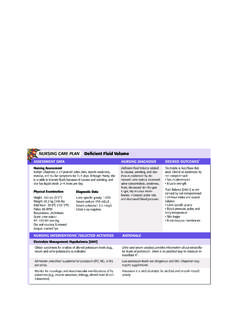Transcription of Fluid and Electrolyte Management - samples.jbpub.com
1 1 Chapter 7 Fluid and Electrolyte ManagementBillie Bartel and Elizabeth GauLe a r n i n g Ob j e c t i v e s 1. Identify and understand basic Fluid and Electrolyte abnormalities in critically ill patients. 2. Differentiate between the types of fluids used for Fluid replacement in different disease states commonly seen in the intensive care unit. 3. Recognize the causes of Electrolyte abnormalities in critically ill patients. 4. Understand when and how to replace or replete electrolytes in critically ill patients.
2 IntroductIonFluid and Electrolyte abnormalities are common in critically ill patients and often represent complications from underlying disease states or medication therapies. Critically ill patients often experience alterations in absorption, distribution, and excretion of fluids and electrolytes. Changes in hormonal and homeostatic processes and Fluid status are also common in intensive care unit patients. 111/2/11 3:16:52 PM Jones & Bartlett Learning, LLC. NOT FOR SALE OR DISTRIBUTION chapter 7: Fluid and Electrolyte Management2 Significant complications can result from Fluid and Electrolyte abnormali-ties, and the severity of these complications usually parallels the magnitude of the disorder.
3 Fluid and Electrolyte disorders occurring acutely and rap-idly are often associated with increased symptoms and complications when compared to chronically occurring imbalances; these symptomatic abnor-malities require more urgent treatment. Recognizing the cause of Fluid and Electrolyte abnormalities is important when making treatment decisions. Critically ill patients often require very frequent monitoring and evaluation of Fluid status and serum Electrolyte concentrations throughout their treat-ment often assist in the Management of Fluid and Electrolyte ab-normalities in the intensive care unit.
4 Working with physicians, pharmacists play an important role in the determination of underlying causes of these disorders, particularly when disorders are medication-related, and in pro-viding knowledge of the potential implications of individual medications. Pharmacists also often evaluate and recommend treatment of Fluid and elec-trolyte disturbances. This chapter will review body water composition and Electrolyte regulation, focusing on the recognition, presentation, treatment, and monitoring of Fluid and Electrolyte disorders.
5 Water and Fluid Imbalances In the crItIcally IllWater comprises a high percentage of body Fluid , with the exact percentage dependent on sex, age, and weight; the approximate percentages of body weight as water in men and women are 50% and 60%, respectively. Total body water is distributed into the intracellular and extracellular space, with the extracellular space broken down further into the intravascular and in-terstitial space. A complete breakdown of body water distribution is detailed in Figure 7 1. The body maintains equilibrium between these spaces by maintaining osmolality in the extracellular space and intracellular space via allowing water permeation between cell membranes.
6 Osmolality is the solute or par-ticle content per liter of water (mOsm/L) with normal osmolality in the plasma between 285 and 295 Serum osmolality can be calculated based on serum levels of sodium, glucose, and BUN using the following equation:2 Serum Osmolality = 2(Na) + Glucose/18 + movement between the intravascular and interstitial spaces occurs across capillary walls by either filtration or diffusion and is determined by 211/2/11 3:16:52 PM Jones & Bartlett Learning, LLC. NOT FOR SALE OR DISTRIBUTIONW ater and Fluid Imbalances in the Critically Ill 3 Starling forces.
7 Normal distributions of Fluid between compartments are commonly altered in critically ill patients before arriving in the intensive care unit (ICU) and will continue if not corrected. Causes of normal Fluid loss are skin evaporation, urination, breathing, and through the gastrointestinal tract, but in critically ill patients, these normal losses are altered and increased through various mechanisms. It is important for pharmacists to evaluate pa-tients in the ICU for Fluid loss and accumulation and to note that each disease state has specific causes of and treatments for Fluid imbalance.
8 Trauma and surgery PatientsTrauma patients lose a significant amount of Fluid through blood loss and third spacing,3 which is a lack of equilibrium between the intracellular and extracellular Fluid . The Fluid remains extracellularly, but moves to areas that usually do not have Fluid accumulation, like bowel lumen, subcutaneous tissues, retroperitoneal or peritoneal space, and the peritoneal cavity. Fluid accumulation in these areas exerts pressure on organs and removes Fluid from the intravascular space, which requires sufficient volume to maintain cardiac output.
9 Surgical patients, either trauma or non-trauma, tend to begin surgery This is due to blood loss from trauma or because of dehy-dration caused by the long-term decreased Fluid intake that occurs in disease states such as pancreatitis or cholecystitis. In contrast, post-operative patients tend to be Fluid positive due to resuscitation during the Figure 7 1 Body water distribution and example for 80kg maleData from: Kaplan LJ, Kellum JA. Fluids, pH, ions, and electrolytes. Current Opinion in Critical Care 2010; 16: 323 331.
10 Intravascular Fluid (IVF)1/4 of ECF = 4 LTo tal body water (TBW) L/kg = 48 LInterstitial Fluid (ISF)3/4 of ECF = 12 LIntracellular fluid2/3 of TBW = 32 LExtracellular Fluid (ECF)1/3 of TBW = 16L Third space Fluid (not included incalculations) 311/2/11 3:16:54 PM Jones & Bartlett Learning, LLC. NOT FOR SALE OR DISTRIBUTION chapter 7: Fluid and Electrolyte Management4 Fluid is also lost through major burns. Intact skin will still lose Fluid , but this occurs to a much greater extent with burns. Fluid resuscitation is extremely important in burn patients because they are at high risk for devel-oping shock,4 and so increased insensible Fluid losses in these patients need to be replaced.













